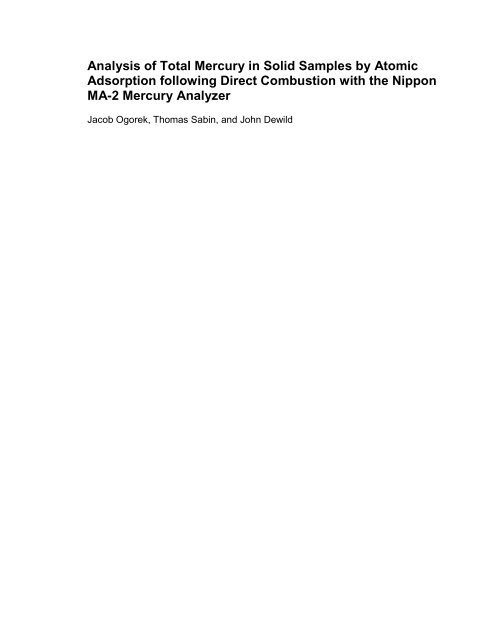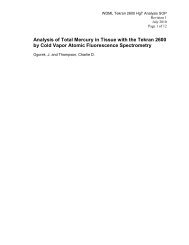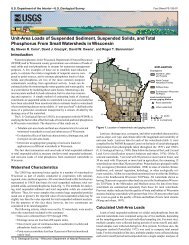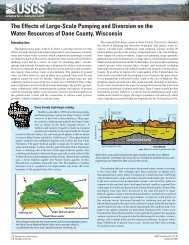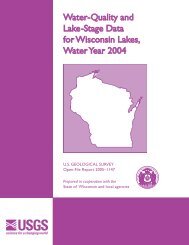Nippon MA-2 Mercury Analyzer - Wisconsin
Nippon MA-2 Mercury Analyzer - Wisconsin
Nippon MA-2 Mercury Analyzer - Wisconsin
Create successful ePaper yourself
Turn your PDF publications into a flip-book with our unique Google optimized e-Paper software.
Analysis of Total <strong>Mercury</strong> in Solid Samples by Atomic<br />
Adsorption following Direct Combustion with the <strong>Nippon</strong><br />
<strong>MA</strong>-2 <strong>Mercury</strong> <strong>Analyzer</strong><br />
Jacob Ogorek, Thomas Sabin, and John Dewild
Principle of Operation<br />
Solid sample is combusted at high temperature (850 C) in the presence of<br />
interference-reducing reagents, releasing mercury from the matrix as reduced<br />
gaseous mercury. In the resulting gas, matrix interference is further eliminated<br />
by catalytic treatment, adjusted to appropriate pH in a phosphate buffer, and then<br />
passed through a gold amalgam trap to quantitatively capture gaseous mercury.<br />
Lastly, the gold trap is heated, releasing the bound mercury into the sample<br />
stream, and detected by cold vapor atomic adsorption. A more detailed<br />
description of the principle of operation is available in chapter two of the<br />
manufacturer’s instruction manual.<br />
Safety Concerns<br />
Multiple safety concerns are present in the operation of this instrument. Although<br />
mercury is a dangerous neurotoxic metal, concentrations encountered in the<br />
samples and standards generally measured on this instrument are relatively low.<br />
However, caution should still be exercised to limit chronic mercury exposure.<br />
Extremely high temperatures are used to heat the catalyst, ceramic combustion<br />
boats, and reagents prior to use. These will remain hot minutes (boats) to hours<br />
(reagents and instrument) after heating; use caution in handling these items.<br />
The automated sample loader and tray start moving without warning during<br />
analysis and are a mechanical hazard. Finally, the powdered analytical reagents<br />
are very fine and pose a severe harmful particulate inhalation hazard (see<br />
attached MSDS for further details). Due care must be exercised in handling<br />
these reagents, and should include the use of appropriate precautions<br />
(particulate filter fume hood, appropriate disposal, and regular cleaning of<br />
surfaces with dust vacuum).<br />
Instrument Operation<br />
This document is intended as an additional standard operating procedure (SOP)<br />
designed to guide the user through mercury analysis specific to the <strong>Wisconsin</strong><br />
District <strong>Mercury</strong> Laboratory. A condensed version is also provided following the<br />
detailed SOP, and is intended as a quick reference bench guide for the analyst.<br />
However, the analyst is required to be familiar with the detailed SOP as well as<br />
the original user’s manual provided by <strong>Nippon</strong> which will be referred to when<br />
appropriate.<br />
Start up<br />
If the instrument is off, turn it on with the switch near the mains. If necessary,<br />
start the software (click on shortcut located on the desktop, “<strong>MA</strong>2000”) and open<br />
the appropriate (HIGH CAL or LOW CAL) template file. The template files<br />
include a standard curve that was successfully used on the instrument for the<br />
previous analysis; it is not necessary to calibrate the instrument with every use.
The LOW CAL file operates from 0.2 – 20 ng and is generally used for sediment<br />
analysis, while the HIGH CAL file operates from 2 – 200 ng and is generally used<br />
for biological analysis. Choose the correct analysis mode (“low mode” for LOW<br />
CAL function, and “high1 mode” for HIGH CAL function) by clicking the drop<br />
down menu “run”, select “mode”, and choose radio button. On the instrument<br />
diagram, make sure that the heat mode is in “mode 2” and the measurement<br />
mode is correct for the intended analysis. If the instrument is “cold” allow it to<br />
come up to operating temperature.<br />
Empty the gas washing bottle (left bottle) of buffer solution, and drain residual<br />
moisture from the dehumidifying bottle (right bottle). Fill the gas washing bottle<br />
with 2 cm of buffer solution, being sure to leave the dehumidifying bottle open to<br />
vent head space (otherwise buffer solution will be forced upstream into the end<br />
cap and require shut down and cleaning). If necessary, remove combustion<br />
boats from sample tray, empty the spent reagent-sample mixture into a large<br />
Ziplock bag, and vacuum residual reagent dust from boats. Gently vacuum any<br />
reagent dust that has collected on interior components of the instrument,<br />
including the sample changing tray and surrounding areas (tray removal function<br />
possible in the “run” drop down menu). Clear the instrument of residual mercury<br />
by running the purge function (select the PURGE option in the sample table from<br />
the NAME drop down menu). Repeat purge until at baseline level (peak area <<br />
0.005).<br />
Preparation for Sample Analysis<br />
It is important that the combustion boats are mercury and acid free. Prior to use,<br />
newly acid washed boats should be heated in the oven at 550 C for 2 hours, and<br />
boats not used in the previous 3 days should be clean burned in the instrument.<br />
If the boats have been recently used, randomly select 10% of combustion boats<br />
(3-6) to be used for the analysis and clean burn (without reagents) them to<br />
ensure that there is no significant carryover (peak area < 0.01) from previous<br />
analyses. If the boats fail this criterion, repeat with 3-6 additional boats, and if<br />
contamination persists the entire lot of boats needs to be clean burned before<br />
use.<br />
When the boats are clean analyze three reagent blanks, at least three relevant<br />
standard reference material (SRM) samples, and two check standards. Analysis<br />
requires the addition of solid reagents to the combustion boats and is further<br />
described in chapter 5 of the instruction manual. For the analysis of standards,<br />
add additive B,10 – 1000 µl of standard, additive B to cover, and finally fill the<br />
boat with additive M. For the analysis of solid samples, add additive M, 10 – 50<br />
mg sample, additive M covering the sample, additive B covering that, and finally<br />
fill the boat with additive M. Following analysis, if the initial reagent blanks are<br />
sufficiently low (< 0.05 ng/boat), the SRM is within the accepted range (± 20%<br />
recovery), and the check standard recovery is within 10%, proceed with sample<br />
analysis. In the case of an elevated reagent blank, and SRM or check standard
ecovery failure, repeat the measurement. A repeated failure rules out analyst<br />
error and indicates that the instrument is not performing properly; samples should<br />
not be analyzed until the issue is corrected.<br />
Sample Analysis<br />
Samples may be analyzed once the preceding instrumental control has been<br />
demonstrated. Analytical sample mass should be 10 – 50 mg. Every analytical<br />
batch of ten samples will include at least: one sample analyzed in triplicate, one<br />
SRM analysis, and two reagent blanks. The reagent blanks, preceded by an<br />
instrumental purge, are located in the middle and at the end of the sample set. If<br />
necessary, additional purges may be added to a batch. A typical analytical batch<br />
is described below:<br />
Sample 1<br />
Sample 1<br />
Sample 1<br />
Sample 2<br />
Sample 3<br />
Sample 4<br />
Sample 5<br />
Purge<br />
Blank 1<br />
Sample 6<br />
Sample 7<br />
Sample 8<br />
Sample 9<br />
Sample 10<br />
SRM<br />
Purge<br />
Blank 2<br />
Instrumental Shutdown<br />
Short-term Instrument Shutdown (< 2 weeks): The heaters operate at a high<br />
temperature and should be turned off following sample analysis. To shut the<br />
heaters off following an analytical run, turn the instrument off with the power<br />
switch. If the batch is to finish unattended, use the “start sleep” function found in<br />
the run menu. Select the samples you wish to run but do not start (the run will<br />
start automatically). Select start sleep and choose the option to that fits your<br />
situation. You can choose to turn heaters off following the run, and if a run is<br />
scheduled for the following day enter the time that the heaters will begin to warm<br />
again.<br />
Long-term Instrument Shutdown (> 2 weeks): For extended periods of inactivity,<br />
the instrument must be prepared for storage. First, follow the short-term
instructions for shutdown. After the instrument completely cools, remove the end<br />
cap and combustion tube (see chapter six in the user manual). Rinse the<br />
combustion tube with copious volumes of reagent water, dry completely, cap,<br />
store in an airtight bag, and record the period of use for the combustion tube.<br />
Acid wash the end cap (see below). Empty the buffer and drying bottles, rinse<br />
and fill the buffer bottle with reagent grade water, and plug the inlet hole. Empty<br />
the spent reagents from the sample boats, acid wash, and store. Finally, vacuum<br />
residual reagent dust from the instrument.<br />
Quality Assurance and Control Protocols<br />
Standard Reference Material<br />
Recovery of the reference material must be within 80 – 120% of its certified<br />
value. Repeat the SRM in the case of failure. A second failure indicates the<br />
method in not performing properly and the problem needs to be corrected and<br />
the samples repeated.<br />
Sample Precision<br />
The relative standard deviation of samples in triplicate should be less than 15%.<br />
In the case of failure repeat the sample (if possible) in addition to another sample<br />
from the same set in triplicate. Repeated triplicate failure should be brought to<br />
the attention of the quality assurance officer.<br />
Sample Carryover<br />
The purge function of the instrument clears the sample train of residual mercury<br />
and indicates the level of carryover from previous sample analyses. A purge<br />
mass should not exceed 10% of the mass of mercury measured in any previous<br />
sample, up to the previous purge. When a purge exceeds 10% of a previous<br />
mercury mass, repeat that sample in a subsequent batch bracketed with purges.<br />
If significant carryover persists in a sample set, mercury concentrations tend to<br />
be extremely low, and/or sample volume is extremely limited, increase the<br />
frequency of purges to reduce inter-sample carryover.<br />
Reagent Blank<br />
Reagent blanks analyzed before and throughout analytical batches measure the<br />
mercury concentration present in the additives M and B. If any one of the three<br />
initial reagent blanks exceeds 0.05 ng/boat, reanalyze three reagent blanks using<br />
the same boats. Repeated failure of initial reagent blanks indicate the additive is<br />
contaminated and should be combusted again before future use. Reagent<br />
blanks throughout the analytical batch are preceded by an instrumental purge to
clear the sample train of residual mercury, reducing sample carryover. Reagent<br />
blanks within an analytical batch exceeding 0.05 ng/boat indicate contamination<br />
of additive source or persistent systemic contamination. Repeat the preceding<br />
samples of a failed reagent blank up to the last passing reagent blank (< 0.05<br />
ng/boat) or instrumental purge with a peak area < 0.005; if sample carryover is<br />
suspected in this batch, the samples should be bracketed with purges. If reagent<br />
blanks continue to fail the repeated analysis, the additive has become<br />
contaminated and should be combusted.<br />
Instrument Calibration<br />
A standard curve should be (1) created with mercury masses appropriate to the<br />
measurement mode, (2) calculated with a polynomial best fit equation with an<br />
intercept of zero, and (3) have an r 2 value greater than 0.995. The mass of<br />
mercury in analyzed samples should occur within the levels of the standard<br />
curve. Instrumental response tends to be relatively stable over multiple days,<br />
therefore daily calibration is not necessary. However, instrumental calibration<br />
should be verified (± 10%) prior to sample analysis by analysis of a known mass<br />
of mercury from a standard solution.<br />
Additional Instructions<br />
Interferences<br />
The instrument is extremely sensitive to acid and free halogens, which degrade<br />
the catalyst and gold trap. It is very important to reduce/eliminate exposure to<br />
these factors throughout analysis and storage. Saline sediments (such as<br />
marine sediments) and potentially acidified samples should be analyzed<br />
sparingly with the <strong>Nippon</strong> or with an alternative method.<br />
Reagents<br />
Before use, heat reagents to 750 C for 1 hr in 250 ml crucible to volatilize<br />
residual mercury and water. Leave in furnace until cool and transfer back into<br />
original container if not immediately used.<br />
Standard Solution<br />
<strong>Mercury</strong> standards are prepared in a 0.001% L-cysteine, 0.2% Nitric acid<br />
solution; do not use standards prepared in any other matrix as that acids and free<br />
halogens substantially interfere with instrument performance. Standards<br />
solutions of 10, 100, and 10000 ng/ml meet most analytical needs of the<br />
instrument.
Data Capture and Processing<br />
Data from analysis appears in the run list in the sample page and is written to the<br />
“DEPOSIT.<strong>MA</strong>” file. In the run list, copy the columns for sample ID, sample<br />
mass, and mercury mass. Paste these data into the appropriate excel spread<br />
sheet template (HIGH CAL or LOW CAL) for processing and save with the file<br />
name as the analytical date (012309.xxx). Following analysis, also save the<br />
DEPOSIT.<strong>MA</strong> file as the same name.<br />
Maintanence Schedule<br />
Daily Gently vacuum the interior components of the instrument to minimize dust<br />
build up. Change buffer solution. Visually inspect the downstream components<br />
(end cap, bubblers, gold amalgam trap, cell, and connecting tubing) for deposits<br />
and clean or replace as necessary. .<br />
Monthly Acid-wash the end cap and inspect the end of the combustion tube for<br />
deposited material. Replace combustion tube and clean as necessary. Acidwash<br />
combustion boats as described below.<br />
Acid Washing<br />
All acid-washing is done in a 10% HNO 3 solution. Wash glass equipment and<br />
ceramic combustion boats for at least 2 and 24 hours, respectively. Rinse glass<br />
equipment well with mercury-clean water and let dry before use. Following acid<br />
washing, boats need to be soaked in mercury-clean water for a minimum of 24<br />
hours to become fully rinsed, dried for 3 days, and heated to 550 C for 2 hours<br />
before use. Cleaning the combustion tube requires special precautions and is<br />
described previously in this text, and in detail (chapter 6) in the supplied<br />
instruction manual.
Quick Reference Guide for HgT analysis with the <strong>Nippon</strong> <strong>MA</strong>-2<br />
<strong>Mercury</strong> <strong>Analyzer</strong><br />
• Turn instrument on with switch near mains<br />
• Drain and fill buffer<br />
• Remove sample tray and vacuum interior of instrument<br />
• Start software and select appropriate calibration file (generally low cal for<br />
sediments, high cal for biological)<br />
• Once heaters are at operating temperature, begin initial purge and boat<br />
blanks<br />
• Analyze reagent blanks, SRM, and check standards. Add the reagents in the<br />
appropriate order (M, Sample or SRM, M, B, and M: or B, standard, B, and M)<br />
TYPE<br />
QA/QC CRITERIA<br />
Instrument purge Acceptable when peak area is < 0.005<br />
3-6 (10%) Empty boat blanks Acceptable if peak area is < 0.01<br />
3 Reagent blanks Acceptable if mass is < 0.05 ng/boat<br />
3 SRM Acceptable if recovery is 80 – 120%<br />
2 Check Standards Acceptable if recorvery is 90 – 110%<br />
• Once the startup criteria is met, begin analysis of samples that include one<br />
triplicate, one SRM, and two reagent blanks that are preceded with purges for<br />
every ten samples<br />
• An example of a typical 10 sample batch is as follows:<br />
TYPE<br />
QA/QC CRITERIA<br />
Sample 1 in triplicate RSD < 15%<br />
Samples 2-5<br />
Within confines of standard curve mass<br />
Instrument purge<br />
Mass < 10% preceding samples<br />
Reagent blank<br />
Mass < 0.05 ng/boat<br />
Samples 6-10<br />
Within confines of standard curve mass<br />
Instrument purge<br />
Mass < 10% preceding samples<br />
SRM<br />
80 – 120% recovery<br />
Reagent blank<br />
• Continue subsequent analytical batches as long as SRM recovery is within<br />
20% of certified value<br />
• Copy and paste data into excel spread sheet and save the spread sheet as<br />
well as the DEPOSIT.<strong>MA</strong> file with the analytical date as the file name<br />
(012309.xxx)<br />
• Turn the instrument off following analysis (use start sleep function if the<br />
instrument will be unattended)


